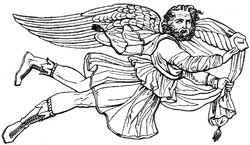Boreas

Or Boras (Βορᾶς), the north wind, was, according to Hesiod,1 a son of Astraeus and Eos, and brother of Hesperus, Zephyrus, and Notus — the so-called Anemoi. He dwelt in a cave of Mount Haemus in Thrace.2 He is mixed up with the early legends of Attica in the story of his having carried off Orithyia, the daughter of Erichthonius, by whom he begot Zetes, Calais, and Cleopatra, the wife of Phineus, who are therefore called Boreades.
In the Persian war, Boreas showed his friendly disposition towards the Athenians by destroying the ships of the barbarians.3 He also assisted the Megalopolitans against the Spartans, for which he was honored at Megalopolis with annual festivals.4 According to an Homeric tradition,5 Boreas begot twelve horses by the mares of Erichthonius, which is commonly explained as a mere figurative mode of expressing the extraordinary swiftness of those horses.
The Romans venerated him as Aquilo.
❧
Iconography
Boreas was portrayed as a stately, bearded old man wearing a wide mantle and with wings attached to his shoulders, holding a conch shell, such as on the Tower of the Winds in Athens (first century BCE). On the chest of Cypselus he was represented in the act of carrying off Orithyia, and here the place of his legs was occupied by tails of serpents.6. A painting by Rubens also shows the abduction of Orithyia by the god.
References
Notes
- Theogony, 379.
- Callimachus. Hymn to Delos, 63.
- Herodotus. Histories vii, 189.
- Pausanias. Description of Greece viii, 36.3.
- Iliad xx, 223.
- Pausanias. Description of Greece v, 19.1.
Sources
- Apollonius Rhodius. Argonautica i, 211.
- Ovid. Metamorphoses vi, 683 ff.
- Pausanias. Description of Greece i, 19.6.
- Pseudo-Apollodorus. The Library iii, 15.2.
- Smith, William. (1870). Dictionary of Greek and Roman Biography and Mythology. London: Taylor, Walton, and Maberly.
This article incorporates text from Dictionary of Greek and Roman Biography and Mythology (1870) by William Smith, which is in the public domain.